Into the Restless Ruins by Ant Workshop is a roguelike deckbuilding dungeon crawling autobattler, and is probably the biggest mash-up of genres rolled into one that I’ve played. It’s easy to say that the developers have cashed in on the popularity of Vampire Survivors, Inscryption, Slay the Spire, the list goes on. But that would be a disservice to how refreshing the game is, whilst also being a little bit of every popular game in this past decade.
The biggest element that makes Into the Restless Ruins so unique is what the dungeons are themselves. You have a top down overview when building out a dungeon with the cards in your deck, as they all act as a room or passageway. On paper, it was an exciting premise, and in gameplay, it delivers. There’s a level of strategy involved that I wasn’t expecting going in. Each card/room has its own shape and entrance points, which forces you to navigate those shapes and connect those points to formulate a cohesive dungeon.
Once you’ve used up your ‘Building Points’ or ‘BP’, you then start your run, or in this game’s case, harvest. The camera zooms in on your Celtic warrior, and you traverse your creation with trepidation, as monsters will come to attack you. Being an autobattler, it’s not so much about what attack moves you can pull off to be a force to reckon with, but rather that strafing in and out between enemies and clever positioning that I picked up from Vampire Survivors. All is to say, I was hooked by its gameplay loop from the start, but how long did those hooks sink in for? I’m sure you’re all restless to find out.
Enter The Dungeon
Inspired by Ant Workshop’s home country, Scotland, Into the Restless Ruins cites Scottish legend and folklore as the basis of the game. The game opens with the words saying, “Scottish Legend tells those whose hearts desire can’t be met by earthly means should seek the Harvest Maiden. In return for their toil she will satisfy their craving.” You are that person who’s seeking the Harvest Maiden, and after a long search based on rumours, you arrive at the ruins entrance.
Once inside, you’re greeted by the Harvest Maiden and offered a granting of your wish, as long as you can harvest the corruption plaguing the ruins. At least I think that’s how it goes. The story is quite light in that regard, a few text boxes here and there to set the world up, with a couple more when you meet characters from Scottish folklore like the Hen Wife or Wulver. It describes the atmosphere and their being, but not enough for me to do any digging on my own accord.
The ending, very minor spoiler, is about as roguelike as you can get. The end isn’t the end because why else would it keep you coming back? That type of thing. Standard run-based game affair at this point and I honestly don’t judge it for that. There’s a clear reverence for all the legends and folklore, which I think speaks volumes more in the gameplay.

No Place Like Homebase
I’ve given a quick rundown of the framework of Into the Restless Ruins gameplay, but there are so many factors to think about that add to the strategic elements. I mentioned that you have ‘Building Points’, which limits how many cards (rooms) you can put down to formulate the dungeon. However, you are building with a purpose in mind, as there are rooms shrouded in fog dotted around the dungeon that you’ll need to get to.
Some may give you more ‘Favour’, which grants you a new card that you choose from one of three, once the bar is filled up, think like XP. Another will give you ‘Relics’ which act as a currency to either upgrade your cards with Hen Wife or buy items from Wulver, as well as other things. But most important of all are the ‘Seals’. Seals block you off from advancing to the boss room, so you’ll need to activate those to get yourself further in the dungeon.
This means you’re looking at multiple nights, multiple harvests and more goes at building your dungeon as the days roll out. However, each night you spend builds up your curse metre, and once that’s full, your run is over. Not only that, but you also go out on these harvests (or runs) each day with a torchlight to illuminate the way. The longer you spend, the dimmer it gets, and once it’s out, you start to lose health. If you don’t make it back to the start during that harvest, the amount of curse you accrue then triples.
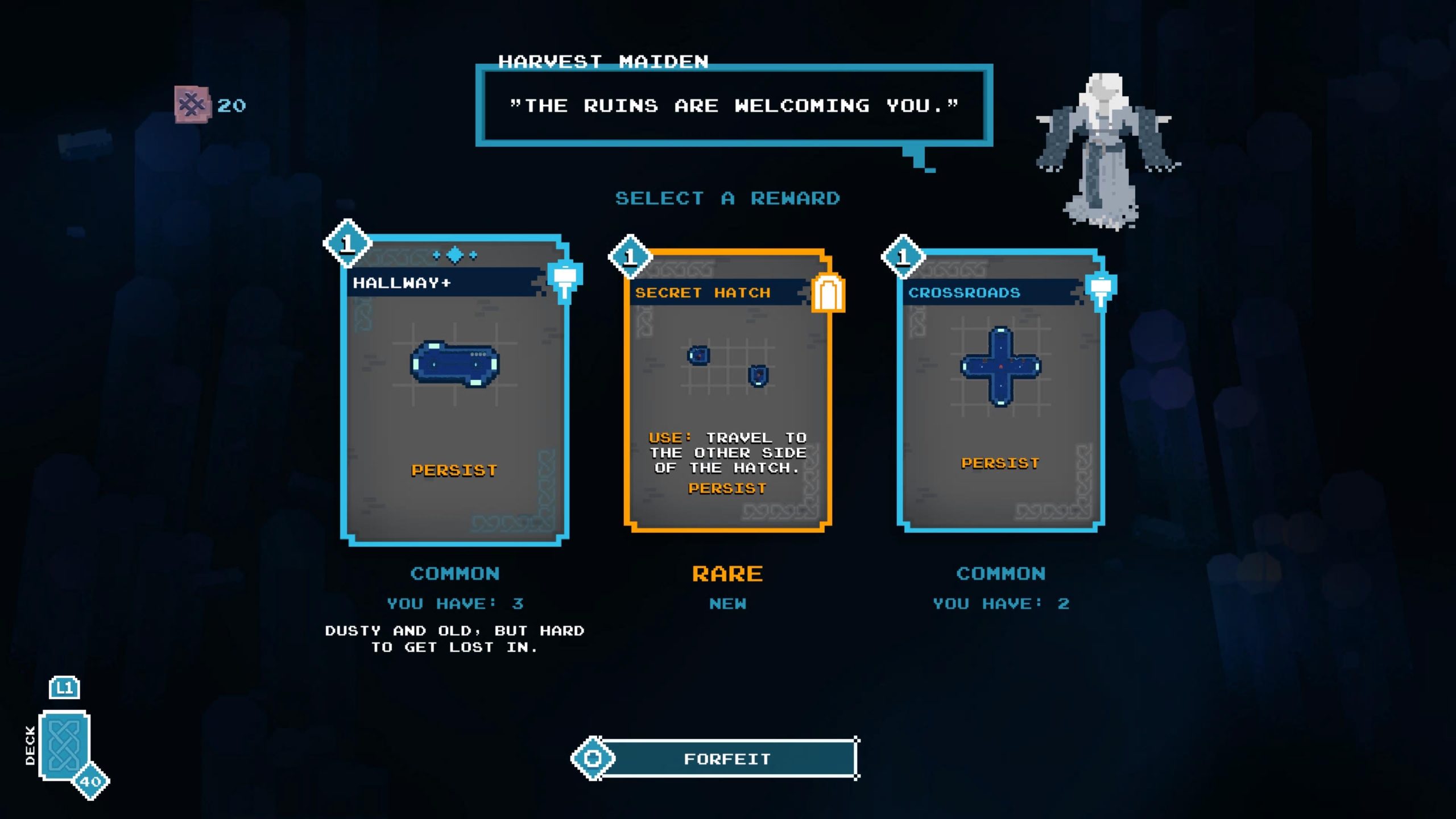
Brave At Heart
Into the Restless Ruins is very much a game with a bunch of spinning plates. Not only are you thinking about your resources and how you should lay out your dungeon, but your ability to go out in it too. How much will you risk? How far will you go before turning back? It scratches that itch of risk and reward, whilst also giving you player urgency to make it a better run for yourself.
Sure, there’s a little bit of RNG from what cards you pull in your deck to set down, but the rest is up to your proper placement and gaining the system. These rooms aren’t only directions to get further into the dungeon, but they can give you buffs too: for instance, camp sites give you more torchlight, training rooms can buff a variety of attack variables like speed, range or damage, some rooms help you in giving more cards per hand; with over 100 cards to pick from as you get deeper in the game.
On top of that, you have a variety of weapons you’ll find on your runs, changing your attack patterns, adding a secondary ranged attack, giving you a decent variety in how you want to play. As you start to unlock the plethora of cards, weapons and buffs, the more you’re empowered by your strategic prowess.
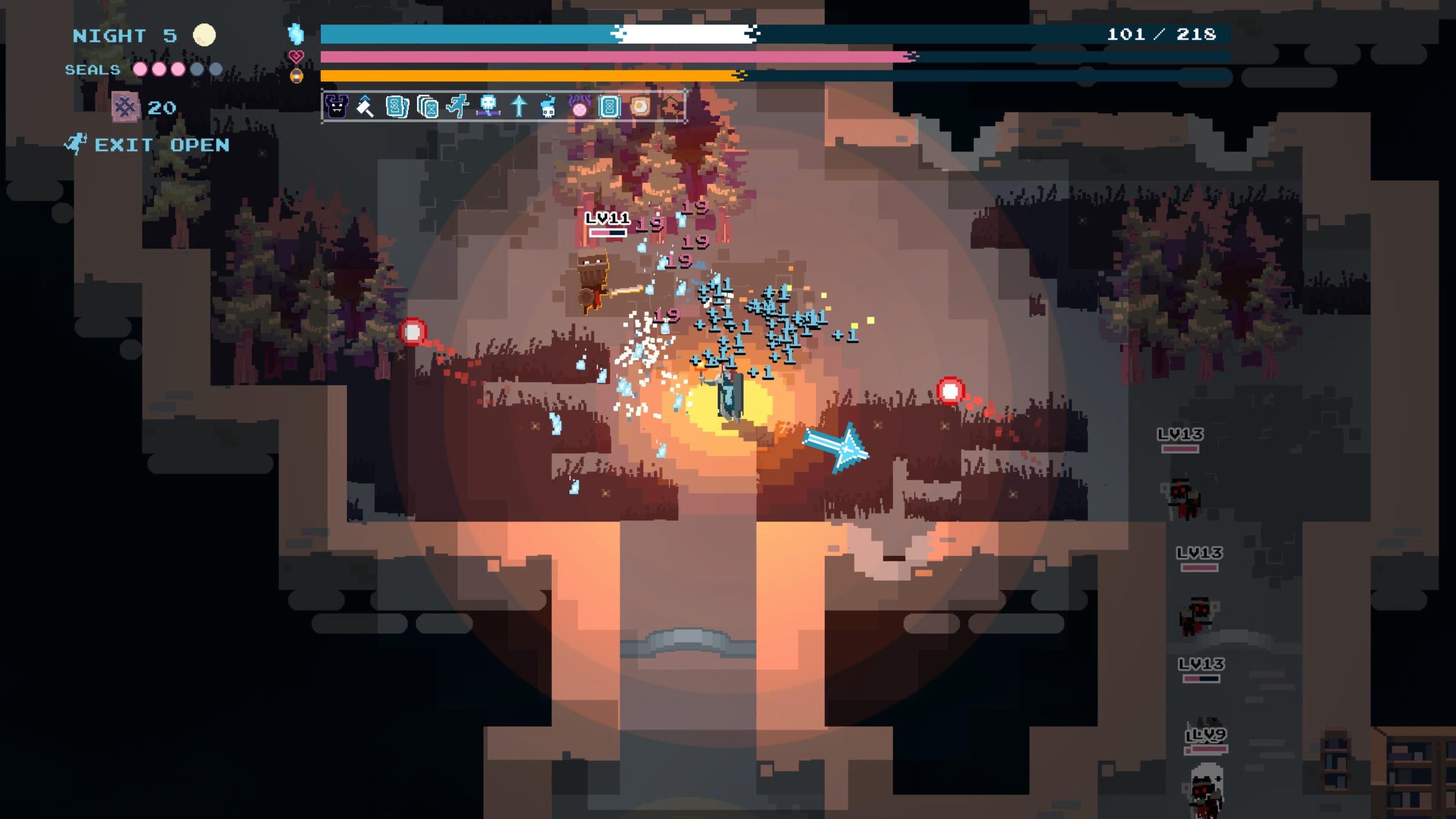
Sowing The Seeds of Hard Work
These are my thoughts after coming off 12 hours with the game, where I’ve succeeded in clearing all the dungeons. Had I started this review only a few hours in, my impression would be more on the negative side. That’s because the early game feels rather punishing. You earn XP each run, and when you level up, you unlock more cards, which are essentially better rooms. Before that, the game was almost too challenging, and I was kind of unsure what my angle to progress was.
Do I try to clear the dungeon like the game wants me to? Or do I explore and experiment and worry more about defeating as many enemies, playing as many cards and getting more XP. The answer was a combination of both, and when I did gain some levels, I started to learn about ‘Cantrips’. These are essentially buffs or debuffs you’ll put on yourself before a run.
Debuffs would increase the multiplier of how much XP you’d gain; these would range from faster or stronger enemies, fewer rewards during the run, or your torchlight burning at a faster speed. The more of these you stack, the greater the multiplier, which I leaned into to level myself up. The buffs, as you’d expect, had the opposite effect with the multiplier, but at the benefit of actually managing to complete runs.
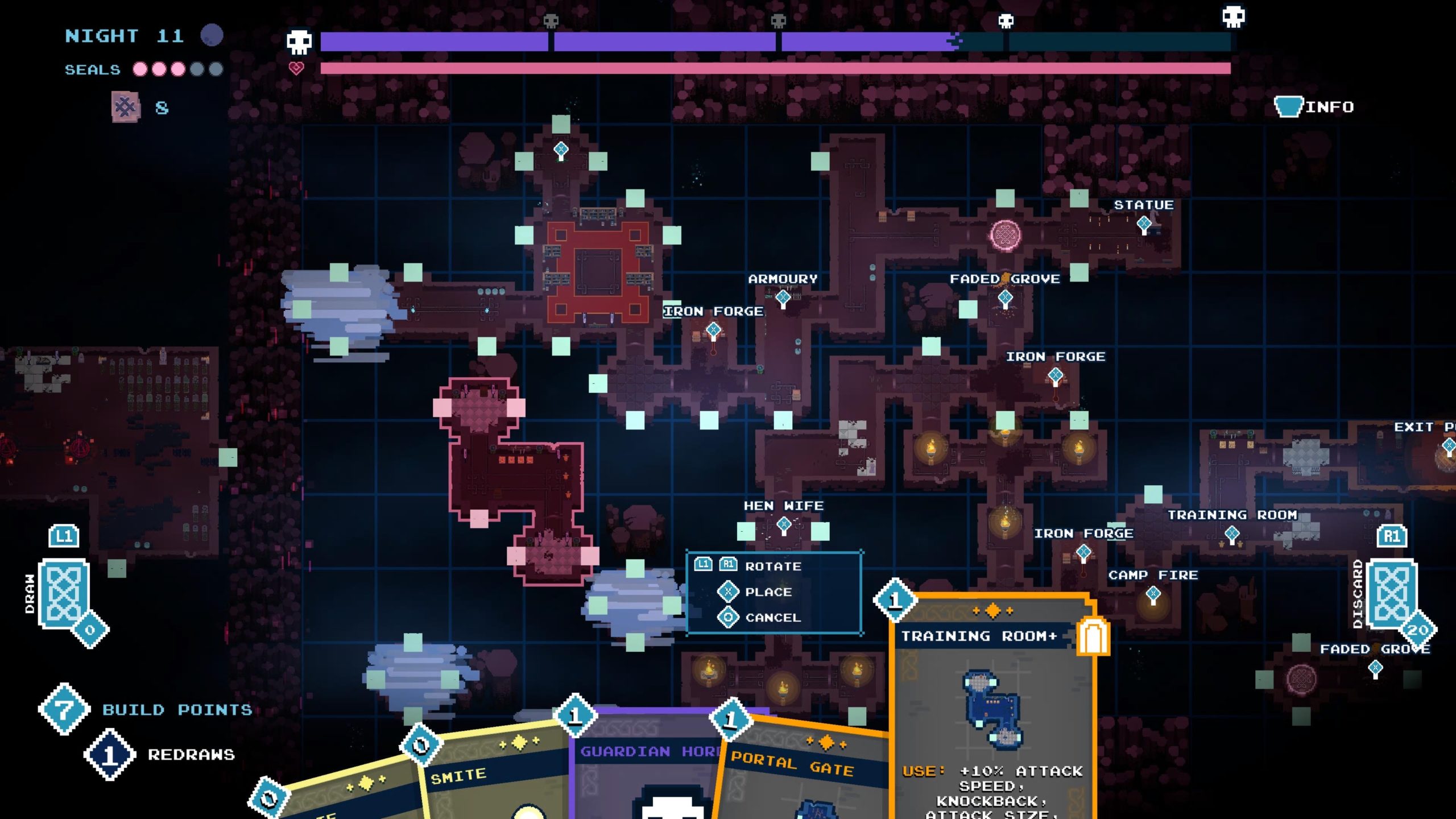
Understanding The Blueprints
It’s essentially a thought out way of creating your own difficulty, which is one of the game’s facets that I appreciated the most. Those looking for a challenge can really make it as brutal as possible. On the inverse, you can feel almost like a God and break the game’s mechanics to essentially make it so you never lose. I love the flexibility that Into the Restless Ruins has, it feels fine-tuned in every aspect of its gameplay and I can’t quite single out a flaw outside of its rough opening hours.
Most of my gripes are with the game’s presentation. Into the Restless Ruins has a pixel art style, which, for the most part, is vivid, imaginative and stylish as hell. However, as you get into more of the dungeons, you realise that it kind of all looks the same. Some of that is due to the rooms having a familiarity to it, visual touchstones to guide you through a dungeon that you need to remember the layout of when playing, because there’s no map and no ability to zoom out to peek at your dungeon’s layout.
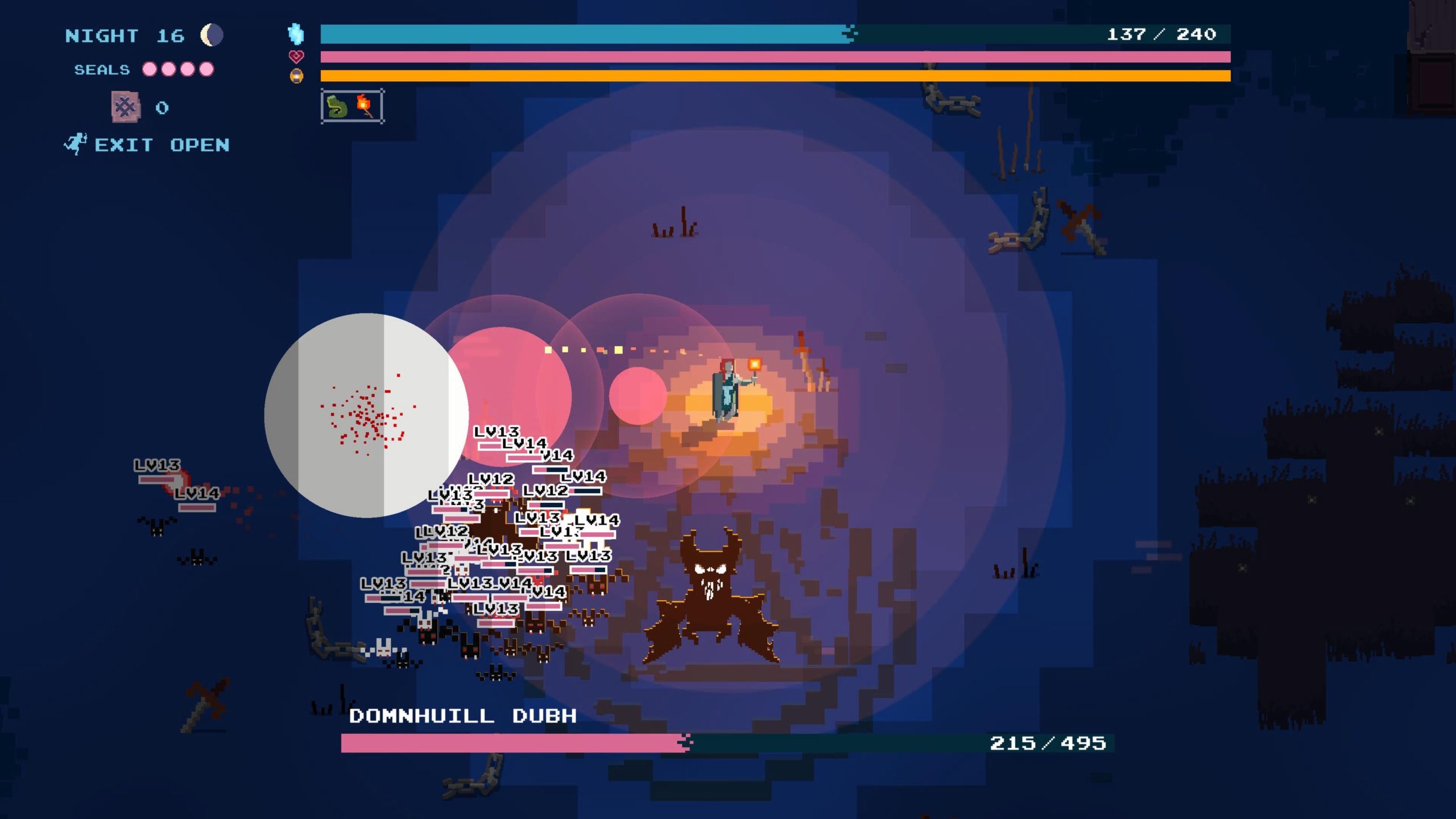
Till The Light Burns Out
I just wish there were just a little bit more variety in the environments that set the dungeons apart a bit more. Enemies also don’t feel as well thought out and look rudimentary in comparison. On top of that, the soundtrack is just one song. It’s a thumping ’80s dark synth banger that doesn’t fit the tone, but definitely matches the colours that pop on screen, though I could have done with some musical diversity to complement the game’s stellar design.
Having said all that, this ended up becoming a game I’d do a run or two whilst having a podcast on. This is a great alternative to other games that fall into that category, whilst also being stimulating in an active sense, because you’re thinking strategically. So whilst I can critique that it’s not necessarily as stylistically robust front to back as I’d like, there’s so much going on in its gameplay that those nitpicks became background noise.
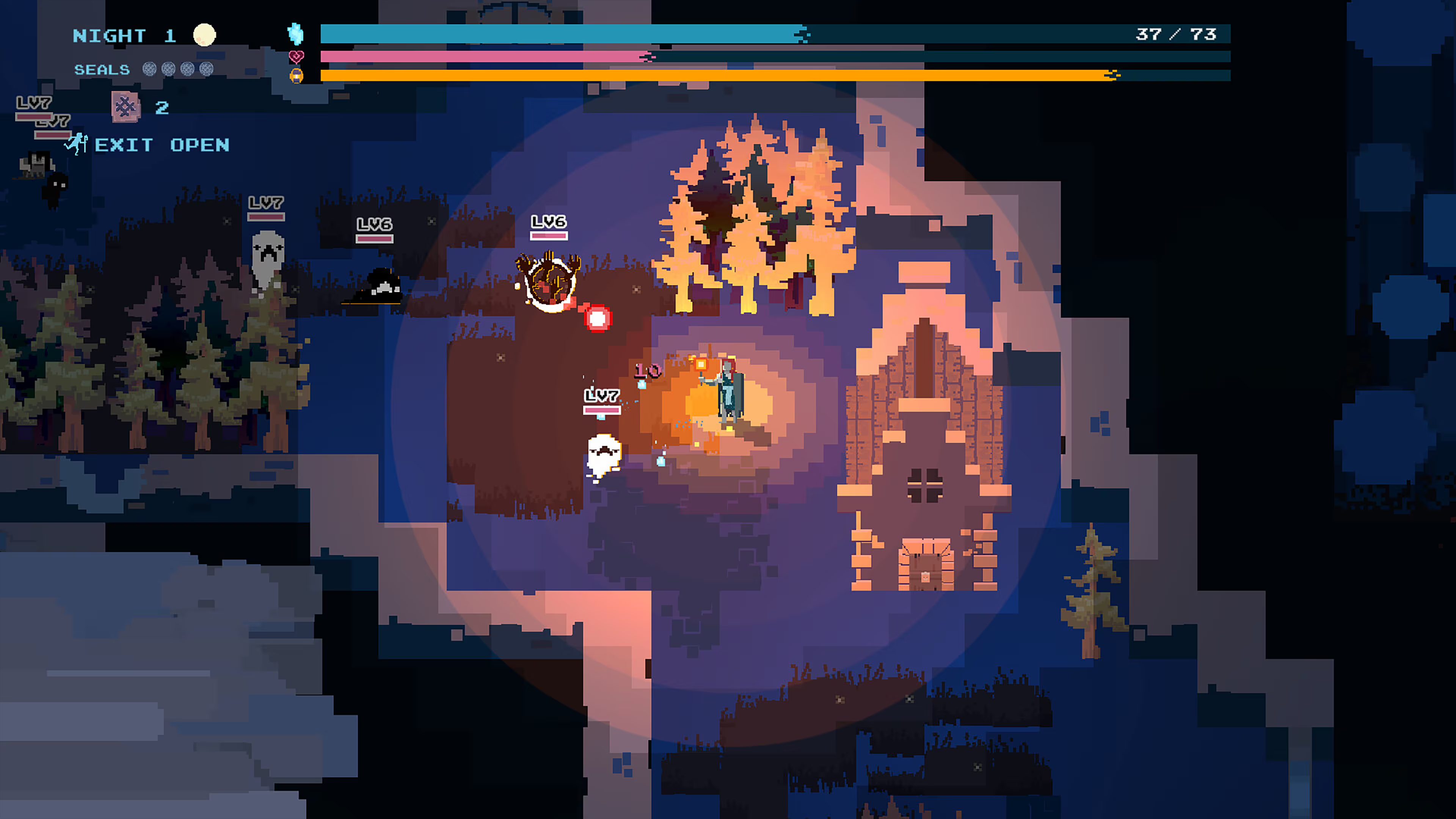
Arresting Ruins
Overall, I had a good time with Into the Restless Ruins. The blend of roguelike, deckbuilding, dungeon crawling and autobattling, meant that it could have that same addictive loop as those genres typically have, but with a new spin on each buzzword. Whether I wanted to make a run near-impossible to beat or as easy as possible, there was always something so satisfying about how the game encouraged me to think.
Despite its many aspects to think about, it felt second nature from the moment I booted it up. The game does feel directionless at the start, when you’re learning the ropes, and there’s no narrative thread to put your efforts into perspective until you start to reap what you sow with rewards from levelling up. It’s a familiar fatigue, and Into the Restless Ruins isn’t moving the needle on that front, but it is an exciting amalgamation of what came before it, with a near-flawless design.
The “one more run” factor is there, with Cantrips modifying each go around to keep it engaging. However, there are only 6 dungeons to beat, so mileage may vary depending on how quickly you beat it and subsequently carry on. I’m at the point where I want to fill out the Compendium, comprised of a bestiary of the enemies, cards to unlock, weapons, etc. So, consider the roguelike hooks well and truly sunk in.
Into the Restless Ruin is out 15th May 2024 for PlayStation 5/4 (review platform), Xbox, Nintendo Switch and PC via Steam.
Developers: Ant Workshop
Publisher: Wales Interactive
Disclaimer: In order to complete this review, we were provided with a promotional copy of the game. For our full review policy, please go here.
If you enjoyed this article or any more of our content, please consider our Patreon.
Make sure to follow Finger Guns on our social channels. Twitter, Facebook, Twitch, Spotify or Apple Podcasts – to keep up to date on our news, reviews and features.
